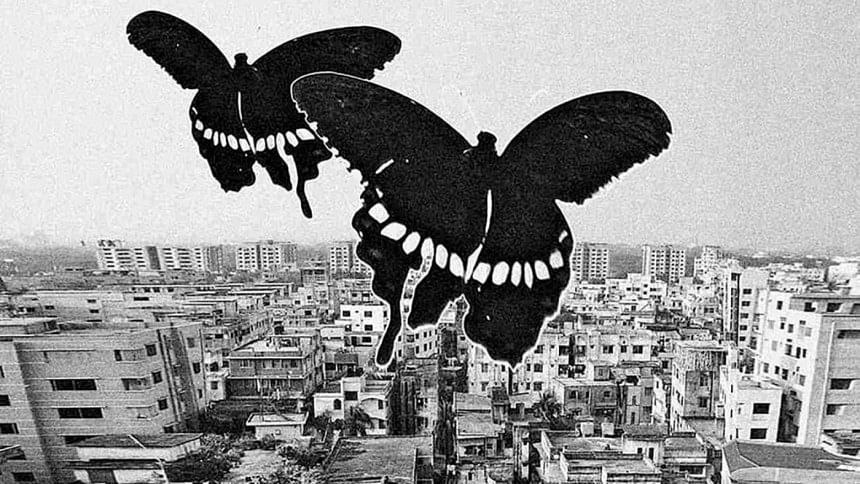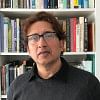Memories, cultural imaginations and Dhaka

How do cities like Dhaka in the throes of frenzied development deal with memories and literary depictions in the process of their transformations? Are there any "provisions" for considering abstractions like memories and cultural imaginations in the planning of cities? Are cities not imaginations as much as they are real? Baudelaire's Paris, Eliot's London, Joyce's Dublin, Fitzgerald's New York, Mahfouz's Cairo, and, more recently, Amitav Ghosh's Kolkata, and Suketu Mehta's Mumbai—are all testament to cities recreated in the virtuality of literature.
I have long wondered about literary Dhaka. How did cultural imaginations of this city shape our perception and experience of it? I slowly understood Dhaka's cosmopolitanism, magic realism, historicism, melancholia and urban absurdities. For a long time, I struggled to ask the right questions about the meaning of this city's quintessential chaos, intensity, congestion, and beautifully infernal urban density. This is a city that narrates its myriad of stories without telling any at all. In many ways, I find myself writing about this city as a retroactive act of penitence for failing to realise how the South Asian capital city reveals its inner stories through the language of spatiality and urbanity. As much as it is about buildings, noisy roads, rickshaws and people, Dhaka is also about the dramas that unfold in its crowded, labyrinthine sidewalks.
One must concoct certain moments during which Dhaka begins to "speak." Such as when I encountered a parrot-man on a crowded Gulistan sidewalk. His obedient green bird, the object of puzzled glances and mass curiosity, idled nonchalantly as hurried passersby stopped to have their fortunes drawn. As soon as one did, the bird sprang into action, trotting down a line of envelopes before making its selection. Inside was a cryptic message about the pedestrian's future that provoked a reaction, but exactly what kind—happy? anxious?—I couldn't tell.
In The City (1929), Theodore Dreiser gushed about his New York, writing: "Nowhere is there anything like it. My City. Not London. Not Paris. Not Moscow. Not any city I have ever seen. So strong. So immense. So elate." Dhaka evokes similar, and of course, dissimilar passions. Some are apocalyptic, some exuberantly romantic, some nonsensically loyal, some fatalistic, and some sarcastic. My Dhaka is a delirious reservoir of a zillion stimuli. It is a laboratory for a host of actors to try out their ideas, fantasies, even jinn stories. It is like the prophesising parrot, both a tale of fortune and a fortune teller.
Dhaka is also a postmodernist setting in which its inhabitants may enact their wildest dreams or weave new historiographies. In Chilekothar Sepai (The Attic Soldier, 1986), the Bengali novelist Akhtaruzzaman Elias recast Bengal's historical syncretism amid the political agitation of late-1960s Dhaka: "Has anyone ever seen such a massive procession in Dhaka? … Days pass, city population explodes, city expands. But who are these people in the procession? Are they the same people who breathe like him [the protagonist] and eat fish and rice like common Bengalis? So many of them seem unfamiliar! Who are they really? Is it possible that people from all historical eras have joined the march?" Elias's Dhaka could never be one thing. It is a cocktail of historicity, politics, rurality, accidental urbanity, and unusual characters. His was a Dhaka both traumatised and energised by the past, the present, and the future. Mostly, it was uncanny, always deferred, and unrelenting in its growth, confusion, chaos and promise.
The other day I was reading Bangabandhu's Unfinished Memoirs. I found one of his most poignant expressions in these lines: "One evening my jail warden locked my door from outside and left. From inside the small room of Dhaka Central Jail, I looked at the sky." I wondered what kind of sky he saw. Was it a rural sky? Political sky? Optimistic sky? Did the clouds weave a map of his shonar Bangla on the sky canvas? Or was it the same melancholic sky that the Palestinian poet Mahmoud Darwish described in his deeply haunting poem "The Earth is Closing on Us": "Where should the birds fly after the last sky?" Darwish encapsulated the existential pain of the Palestinians by imagining it in the shape of birds that no longer had any sky to fly to. Did an incarcerated Bangabandhu see a sky that mirrored the political agitation that raged in Dhaka and beyond?
I wondered about poet Shamsur Rahman's Dhaka: "City city Dhaka city, this strange city, This city has many zigzag alleys." Was "strange" a metaphor for urban alienation or the urban intrigue of Old Dhaka's zigzag alleys? Is there a common thread between Shamsur Rahman's alley and Naguib Mahfouz's Midaq Alley, a bustling Cairo back street that serves as a conceptual theatre for all kinds of stories of life? Visiting the coffee shops that Mahfouz frequented at Khan el-Khalili, the thriving bazaar in the historic centre of Cairo, I thought Shamsur Rahman and Mahfouz depicted the same human spirit that makes a city a city. Yet, both the imagination and the provocation of the human spirit are sparked by the spatiality of cities, streets, buildings, and their complex social interrelationships.
Great cities preserve the physical remnants of those historical traces that made them great in the first place. While in Prague, I followed the "Kafka trail" to understand how Kafka and Prague created each other.
A week ago, I was returning to Dhaka from Chattogram on a train. From the window I watched a country undergoing a rapid transformation. Buildings are rising everywhere, blocking the view of Bengal's archetypal pastoral landscape. At some point I fell asleep. When I woke up after an hour or so, I freaked out seeing nothing outside. It had been almost 11 hours since the train left the Chattogram station and we were still not in Dhaka. The train sped along the tracks, but where was the train going? Finally, a fellow passenger, visibly worried, disclosed to me that the train hurtled past Dhaka because there was no station to stop at. The train could only pierce through a void. There was no Kamalapur station. When I looked outside there was only emptiness. Was this my Kafkaesque nightmare? All great literary works are in the end an act of activism.
Adnan Zillur Morshed is an architect, architectural historian, and professor.
He can be reached at [email protected]

 For all latest news, follow The Daily Star's Google News channel.
For all latest news, follow The Daily Star's Google News channel. 



Comments